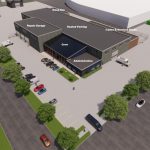Barrett looks for savings, partners and improvements
How do you improve a city that is teetering on the brink? You look for ways to save money; you look for partnerships to make the city attractive to homeowners and businesses; you leverage your contacts to improve infrastructure to stimulate the economic future of the region.
If you’re Tom Barrett, you will and are doing all those things to make Milwaukee a better place. That was the mayor’s message at his annual State of the City speech, given at the newest Job Corps location at 60th and Mill Road.
Barrett announced a number of development and economic growth programs he will be spearheading, including a privately-directed redevelopment of the west end retail corridor of Wisconsin Avenue.
While this portion of downtown has been stagnant, Barrett is enlisting people who are directly involved in the area – the business owners, developers, retail experts, architects and academics – to bring fresh ideas for the area. The city will provide background assistance and work to remove barriers to new development.
Barrett also wants to promote creative professionals such as architects, musicians, artists and designers. He has partnered with the Milwaukee Economic Development Corporation, which will re-tooling its financial products to provide capital to encourage and develop the growth of these jobs and services.
And it wouldn’t be a Barrett speech without the mention of trains. Even though Gov. Scott Walker has turned away the $831 million in high-speed rail funds and one of the mayor’s major job wins, Talgo, is talking about leaving the city, Barrett refuses to give up.
“Just last month, I met with U.S. Transportation Secretary Ray LaHood to discuss the viability of financing the improvements on the Hiawatha Line through a second round of high-speed rail funding.”
Barrett cited the steady increase in ridership on the Milwaukee-Chicago line, with 783,000 riders in 2010, a 6 percent increase from 2009 and a 49 percent increase over five years.
Barrett also wants to help homeowners and those looking to move into home ownership to prosper in the city. He congratulated US Bank and Pyramax Bank for providing mortgage assistance to people purchasing a foreclosed home in the city. He also announced a plan to clean up blighted neighborhoods.
In cooperation with the Common Council, Barrett will work to improve neighborhoods and the rate of home ownership. One way of doing that is the Block Stabilization Program, which will provide monetary incentives to homeowners to improve their properties in neighborhoods where two or more homes are in foreclosure. The money can be used to make exterior improvements, which will make neighborhoods more attractive to buyers.
And if you’re wondering what side of the budget bill issue the mayor is on, he is standing firm with the union workers marching on Madison.
Barrett agrees there needs to be shared sacrifice between public employees and taxpayers, including having city workers pay more for their benefits. But Barrett is vehemently against attacking the fundamental right of workers to organize.
Barrett also stated that Walker’s plan to share the pain will disproportionately hurt the City of Milwaukee, with large cuts to the state shared revenues and the exemption of police and fire unions from the contribution requirements and bargaining restrictions.
“With close to two-thirds of our operating budget costs for salaries and benefits going to police and fire, we’re going to have a very difficult time preserving all current services” without their participation, he said. “And a cut to shared revenue is a cut to public safety.”
Barrett accused Scott Walker of passing the costs of public safety on to the cities, which will create a huge hole in the municipal budget. In an effort to stave off the pain in Milwaukee, Barrett is developing partnerships within the county.
“My priorities are to protect the essential services we provide,” Barrett said. “This morning, I’m pleased to report a cost-saving, cooperative arrangement between governments. “
Soon the city and county will finalize a plan that will designate the City’s Public Safety Communications Center as the central answering point for all incoming 911 cell calls. This will eliminate the need to transfer emergency cell calls between the agencies and improve the quality and efficiency of 911 services.
Barrett is also working with the Public Policy Forum and the Greater Milwaukee Committee to examine the costs and policies involved to combine the city and county’s public works departments.
Barrett is also encouraging the members of the Milwaukee Intergovernmental Cooperation Council to consider combining all municipal health departments within the county.
He pointed to current partnerships between the city and suburbs as examples that this will work in the future, such as the city providing fire services to the Village of West Milwaukee or the consolidated North Shore Fire Department. The county also has partnerships with municipalities, such as providing IT services to West Allis and Cudahy.
“The challenges we face are serious,” said Barrett. “But if we stand together, if we make a commitment to Milwaukee, we can and will keep our city on the path to success.”






















